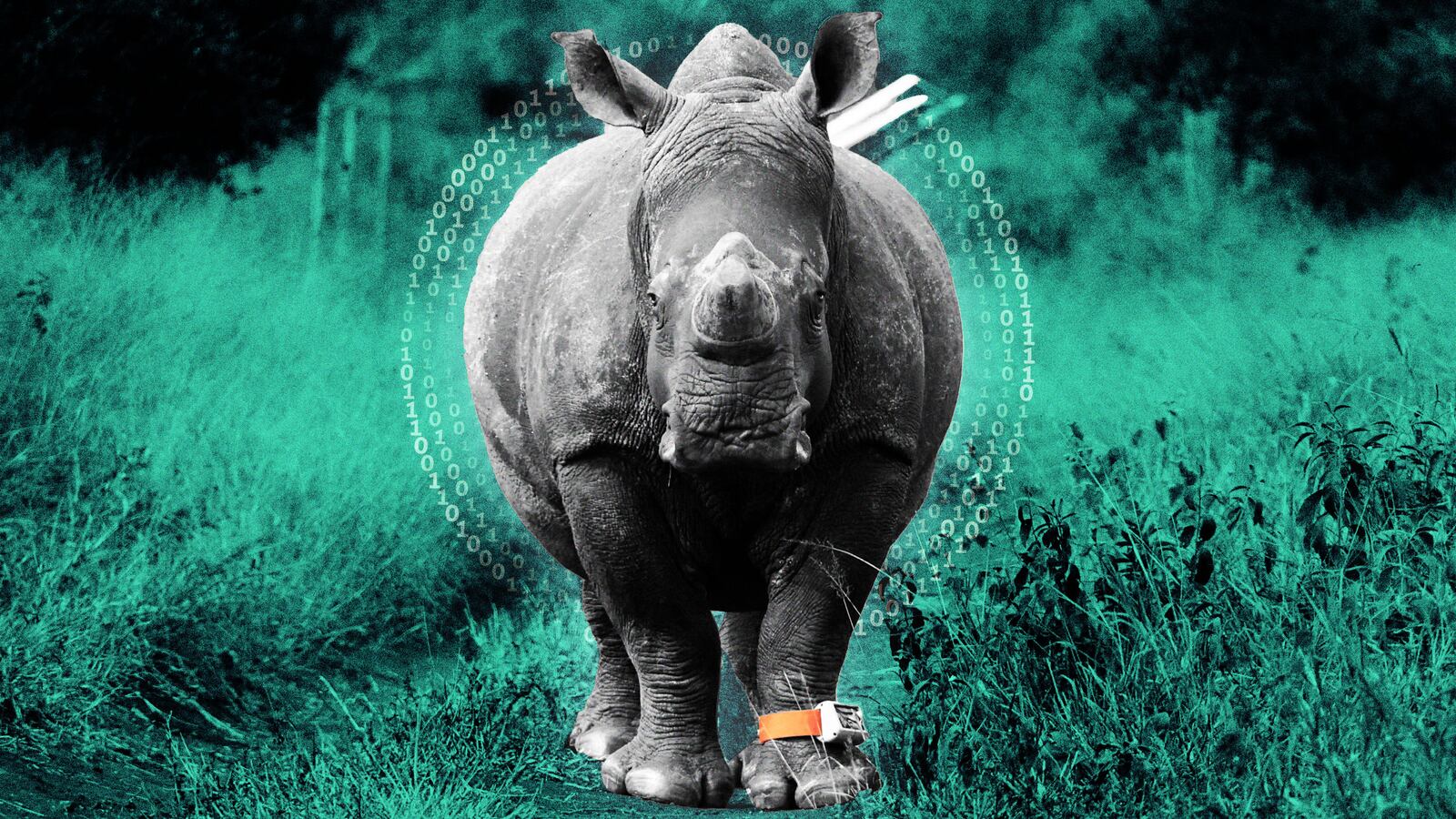At Thanda Safari, a nature reserve in the KwaZulu-Natal province (KZN) of South Africa, a conservation team stands over the motionless body of a female black rhinoceros. With a chainsaw, a rhino custodian removes the anesthetized animal’s horns. The procedure has become one of the best deterrents against poaching of the ungulates, whose horns are used as both unproven medical treatments and status symbols—and fetch more than the price of gold in Asia.
The method isn’t without consequence. Dehorned white and black rhinos are less able to defend themselves against threats. They also experience disrupted social networks and reduced home territories, which may affect breeding—a detriment to a population that numbers only about 27,000 worldwide. Although poaching has declined since its height in 2015, 448 rhinos were slaughtered in South Africa last year. More than half were in KZN.
Before the rhino wakes up, custodians slide around its ankle a flexible, composite-leather belt affixed to a square plastic device with a large, front-facing solar panel. Developed by Cape Town‒based Rouxcel Technology, the RhinoWatch collar functions something like a giant smartwatch, using artificial intelligence (AI) to help learn the animal’s behavior patterns. It’s the latest technological tool in the fight against poaching, and may save this rhino’s life—even after her horns grow back.
Technology such as radar have been used in nature and wildlife conservation since the 1950s. Until relatively recently, though, the efforts have been relatively primitive compared to the technology we have today. “It was visual recognition, relying either on [trail camera] video footage or photos from a satellite or drone, to see if we could identify the actions and trace paths to catch the criminals,” Neil Sahota, AI adviser to the U.N., told The Daily Beast.

Conservationists from Thanda Safari fit a RhinoWatch collar onto a rhino. AI streamlines what has traditionally been a manual and very labor-intensive effort, which is multiplied by the thousands of acres typically managed by a park.
Courtesy Thanda SafariThis led to the development of technologies meant to prevent, rather than simply react to, poaching such as RFID tracking tags, which use microchips not unlike the kind implanted in domestic dogs and cats to identify individual animals; or VHF collars, which emit a pulsed radio signal to identify the location of wildlife.
“The design of the early collars or ankle bracelets was pretty primitive, and a lot of rhinos actually got injured by them,” Lorraine Doyle, wildlife manager of Thanda Safari’s 35,000-acre park, told The Daily Beast. A leap forward came in the form of IoT sensors, which detect changes in the environment and collect the data for real-time sharing. The sensors were used to capture audio data to benchmark normal habitat noise and detect abnormal sounds—such as the hum of a truck’s engine or the bellow of a chainsaw.
The RhinoWatch collar was invented by S. P. le Roux, a soft-spoken electrical engineer with a thatch of sandy hair and a passion for animal conservation. He began working on an animal tracking and theft-prevention system while still in university, after poachers filched more than 200 sheep from his uncle’s farm. Around 2013, when South Africa was still losing more than a thousand rhinos per year to poaching, he turned his focus toward using AI.
The RhinoWatch utilizes AI models along with GPS to continuously monitor the animal’s location and behavior, and ping communication towers at regular intervals. The solar panel extends the life of the battery to last several years, so conservationists don’t have to worry about swapping out fresh batteries frequently. If the collar detects unusual behavior, it creates alerts that are color-coded by level of severity and sends them to a monitoring platform. For example, the collar might create an alert when a rhino wanders outside of its normal range within the park.
From there, specialists at the reserve can decide on a course of action—including sending in K9 units, or anti-poaching personnel on foot or via helicopter to investigate.
When asked whether the collars detect an increase in blood pressure or a shift in movement patterns, le Roux chuckles. “I don’t really know,” he told The Daily Beast. “AI is a little bit of a black box, and it learns as it’s going.”
“It is basically analyzing all day, and figuring out for that specific animal what’s normal behavior,” he added. “And if something is out of the ordinary—whether that’s two animals fighting, an injured animal not moving, or a female giving birth—it will report it.” While the alerts themselves don’t specify what the AI model has deemed abnormal, in the case of a birth, for instance, the system might detect the cow’s agitated movements, followed by her lying down for an extended period.
AI streamlines what has traditionally been a manual and very labor-intensive effort, which is multiplied by the thousands of acres typically managed by a park. “AI is able to look at millions upon millions of variables in real time, so it gives us a lot more insight into, for example, animals’ movements and migration patterns,” Sahota explained. A combination of different technologies used together “paints a much quicker, more robust image.”

A rhino is being fitted with the RhinoWatch collar. The device utilizes AI models along with GPS to continuously monitor the ungulate’s location and behavior, and ping communication towers at regular intervals.
Courtesy Thanda SafariThe RhinoWatch is currently used on 350 animals across 20 reserves in South Africa. It might seem like a drop in the bucket, but with AI’s seemingly limitless potential to learn, given the right data, the technology might be radically advanced in a couple years’ time.
At Thanda Safari, whose rocky terrain is carved out of hills and deep valleys that often become impassable during the rainy season, the technology is providing valuable location data. The park is home to dozens of species, including the “big five” plains game animals: elephants, lions, leopards, buffalos, and black and white rhinos. Doyle, an affable Zimbabwe-born nurse who left a successful career in the U.K. to join the conservation fight, appreciates the ability to boot up her computer and see where each collared rhino is in the park.
Still, Doyle says the device won’t replace dehorning, a practice first implemented in Namibia in the late 1980s. In 2019, in the northeast corner of South Africa, Kruger National Park, the country’s largest reserve at 8,800 square miles, adopted its own dehorning strategy to protect rhino cows. This prompted poachers to move south, requiring parks like Thanda to follow Kruger’s lead.
While effective, dehorning comes with a price tag of around $620 to $1,000 per animal per session. And it’s not permanent. Rhino horn is made up of calcium, melanin, and keratin, and regrows at a rate of up to seven centimeters per year. Every two years, the animal has enough horn to necessitate removal.
Although Thanda Safari hasn’t experienced an illegal incident since 2016, Doyle said that “none of us can sit here complacent.”
“Back in the ’70s and ’80s, when poaching was quite bad, the [criminals] had a bolt-action rifle and an old pair of sneakers,” she explained. “Now the poachers are being equipped with night-vision equipment and automatic weapons. It’s a different league.”
The Rouxcel devices like RhinoWatch help even the playing field. Le Roux points to a recent incident on a South African reserve, where all but three cows with new calves had been collared. Two teams of poachers targeted the collarless animals, killing and dehorning two of the rhinos. In the process of gunning down the second, they accidentally nicked a third rhino, which was wearing a RhinoWatch. The reserve’s monitoring team was alerted, and they were able to apprehend some of the poachers.
“People will say, ‘It’s late detection, because you lose the animal,’” le Roux explained. “But poachers will come in and harvest animals without stopping until you disturb them. So if you have all of your animals collared and they shoot or spook the first one, you will be on to them and save [additional] rhino lives.”

A rhino from the Thanda Safari strolls through the part with a RhinoWatch collar on its foot. According to Sahota, early estimates indicate that the equipment may be responsible for a 30 to 35 percent reduction in poaching in parts of Asia and Africa.
Courtesy Thanda SafariHowever, at $800 per unit, the collars can be cost-prohibitive. Factor in the optional drone system, which runs $8,000 to $10,000 and can be deployed within minutes to investigate alerts—particularly handy for large conservation areas with difficult-to-traverse terrain—and the full capability of the system is available only to well-funded parks.
Another challenge is convincing government and municipal entities, and even park managers, of the importance of a largely unproven new technology—especially given the steep price point. “There’s ROI,” Sahota said. “How do you calculate the value of something that did not happen?”
To alleviate costs, le Roux recently established Rhino Custodians, a nonprofit that accepts donations that will be put toward the RhinoWatch technology in conservation areas, beginning with those in the most need. “My dream is to try to get this out to everyone for free,” le Roux said.
Financial costs aren’t the only hurdle. South Africa has also grappled with ineffective or corrupt law enforcement, leaving reserves largely on their own to deal with poachers. And in a country where 55 percent of the population lives in poverty, residents occasionally find a “solution” in illegal trade cartels that traffic wild animal pelts and body parts, either for trophies or traditional medicine. Doyle says that some cartels offer up to a year’s income solely for information on the whereabouts of endangered animals.
“We need to make rhinos more valuable alive than dead, particularly to local people living on the borders of these parks,” Doyle said.
As with all new technologies, AI-driven conservation devices still need refinement—but they do show promise. According to Sahota, early estimates indicate that the equipment may be responsible for a 30 to 35 percent reduction in poaching in parts of Asia and Africa.
“Our ability to observe animals in their natural habitat, behaving normally, is a really powerful thing,” Sahota said. “We can draw an incredible baseline, so that we can see a very small variation and target that.”
“What we’ve heard from other reserves that have been using the system for years is that it has changed the way they monitor their rhinos by making it easier to keep eyes on them and warning when animals are sick or injured,” Mariana Venter, wildlife operations coordinator at Thanda, told The Daily Beast. “The idea is also to get the word out to the poachers that this system is smart, and poaching these rhinos might not be a great idea.”









